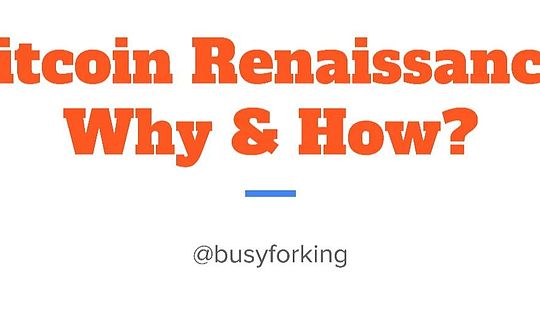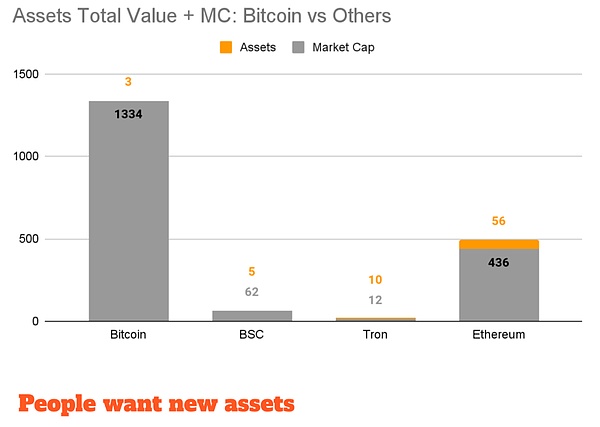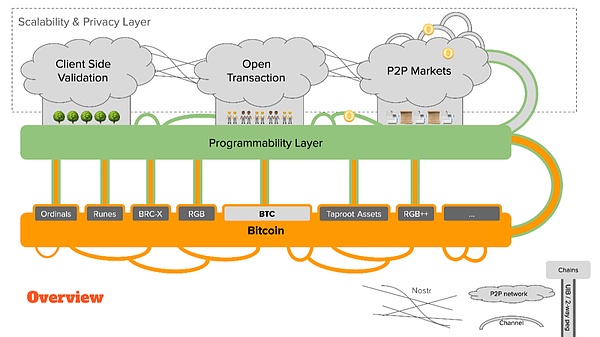
On March 9, at the Bitcoin Singapore 2024 conference co-organized by Nervos Foundation and ABCDE, CKB Chief Architect Jan Xie delivered a keynote speech “Bitcoin Renaissance: Why & How?”.
The following is based on Jan Xie’s English speech:
Why is the Bitcoin Renaissance needed?
Why do we need the Bitcoin Renaissance?A simple answer is that everyone wants to use BTC.
At present, there are many Bitcoin L2 projects, and users are transferring their BTC to these L2s and locking BTC on these L2s.The problem is that people also move BTC to other platforms, such as to Ethereum, not just to orthodox Bitcoin L2.Moreover, the amount of BTC on Ethereum is much more than the amount of BTC in Bitcoin L2.What’s worse is that more BTC is actually stored in centralized exchanges, such as Coinbase’s cold wallet, which has about 1 million BTC.

What I want to say is that people don’t just use BTC as a tool for store of value (SoV), they also want to use BTC, use BTC to pay, participate in transactions or do something else.Whether or not Bitcoin extremists like it or not, if we do nothing, others will do it and they will offer worse solutions because BTC is like water, flowing everywhere.
Another need we can see is that people want new assets.So far, the total value of assets issued on the Bitcoin blockchain is US$3 billion, far behind the total value of assets issued on other blockchains.Bitcoin is the safest, most decentralized, and most censored platform, but the total value of assets issued on this platform is the least.For comparison, Tron has a market value of approximately US$12 billion, while the total value of assets issued on the Tron blockchain reaches US$10 billion.Do you think this is a good thing or a bad thing?

I want to emphasize again that if we do nothing now, others will do it and they will provide worse solutions, and everyone can only use what they do.
After the Ethereum main network was launched, Peter Todd and Greg Maxwell pointed out in 2016 that there was a problem with the Ethereum architecture, which was not the direction this industry should follow.However, over the past 8 years, as Bitcoin has not made substantial progress in meeting real needs, the entire crypto industry has turned to a direction we don’t want to see: building everything on PoS, account models are blooming everywhere, sharding,Expansion solutions such as Rollup have become the mainstream.I don’t think this is the way the crypto industry is going.
Bitcoin has brought a lot of real innovations, but the industry has abandoned all of these things over the past few years, such as PoW, UTXO, P2P networks.
So, why do we need the Bitcoin Renaissance now?I think the reason is that there is indeed a real demand, there is a demand for new assets, and a demand for Bitcoin usage scenarios.Therefore, I hope we can take advantage of the Bitcoin Renaissance opportunity to change directions in the entire crypto industry, follow Bitcoin’s architecture, values and ideas, create new things and move in the right direction.
Some historical introductions to Bitcoin
Bitcoin’s values, as written in the white paper, are a peer-to-peer electronic cash system.It is not a peer-to-contract that we can see everywhere now, nor is it a peer-to-sequencer like Rollup.
Bitcoin is based on PoW and UTXO, and UTXO is a better way to keep your account than the account model, because on UTXO we can create truly peer-to-peer assets, create bearer assets, just like cash, rather than pointThe assets of the contract are not the balance of any number in the account.
Bitcoin focuses on verification rather than computing. It emphasizes self-custody and emphasizes that “no key means no currency, and the coin key is one.”
How to build a better blockchain?The Bitcoin community has discussed a lot.For example, Peter Todd wrote a series of articles and blogs to discuss various ideas. I think three of them are very important, namely:
-
“Disentangling Crypto-Coin Mining: Timestamping, Proof-of-Publication, and Validation”, 2013
-
“Building Blocks of the State Machine Approach to Consensus”, 2016
-
“Scalable Semi-Trustless Asset Transfer via Single-Use-Seals and Proof-of-Publication”, 2017
The core point of Peter Todd is that we only need Single-Use Seal, we need to create a blockchain that is all single-use sealed, without other things on the chain, we need to use all the computing and even moreThe verification is placed off-chain, which is what client side verification (Client Side Validation) needs to do.We need to put more things on the chain and we can build many new products off the chain, such as dye coins, RGB, Ordinal, Atomicals, etc.
We can also create channels off-chain. The channels that are already available are Lightning Networks, but in fact, there are many related research on the architecture and channel design.Interestingly, you can think of the channel as client verification between both parties, which in my opinion is also a type of client verification.
The Bitcoin community also has many ideas about the L2 chain.There have been many related discussions before. The L2 chain is not new, and it is different from Ethereum’s L2, not Rollup.There are two dimensions to measure the L2 chain. One is a consensus mechanism, such as merge mining, staking and a chain with independent consensus mechanism (Sovereign Chain). The other dimension is the way to connect L1 and L2, which is called Two- in Bitcoin.Way Peg (2WP).Interestingly, the underlying chain and off-chain protocols are orthogonal, such as CSV and channels.This means we can merge them into one piece.
The problem now is that the Bitcoin community has already had a lot of great ideas, but so many years have passed and it has been slow.The first reason is that Bitcoin is not programmable enough, and the second reason is that Bitcoin itself has its own characteristics. Bitcoin strives to avoid changes. It is very difficult to add any changes to the Bitcoin protocol.This is also the reason why we have a meeting here today.
How to achieve the Bitcoin Renaissance?
How can we get what we want?If we want to do anything in this circle, there are three principles:
-
Meet the needs of users
-
Comply with Bitcoin’s values
-
No dependency on any soft forks/hard forks
Fortunately, users want to issue new assets, and users’ needs have always existed, and there are also some asset issuance agreements, such as Ordinals, Runes, BRC-20, Taproot Assets, etc.We can issue assets on the Bitcoin chain, issue peer-to-peer, censorship-resistant assets, and there is no need for Bitcoin to make any changes or forks.This ability to issue assets on the Bitcoin chain is limited only by our own brains inherent in mind or Bitcoin extremist ideas.Issuing assets on the Bitcoin chain will actually bring many benefits to Bitcoin. For example, the more assets issued on the chain, the higher the miner’s fee income, which means that the more security budgets will be for Bitcoin in the future.
We also need a programmable layer because Bitcoin itself is limited and we can’t do a lot on the Bitcoin chain.If we could create a layer based on Bitcoin, giving Bitcoin on-chain assets programmable, we could do a lot.This programmable layer will be the basis of everything else, including scalability, privacy, Bitcoin financial activities, and more.This programmable layer will be the hub of Bitcoin’s on-chain assets, which is completely different from Ethereum.Ethereum is programmable, so it doesn’t require a programmable layer, but Bitcoin needs it.
Then we need the highway between Bitcoin and the programmable layer.We can use Two-Way Peg (two-way anchoring), or use an innovative approach to bridging assets between Bitcoin and programmable layers, which I call UIB (Universal Isomorphic Binding)Certainly).The idea of UIB originated from Cipher, who isRGB++ protocol, and isomorphic binding is one of the core technologies of RGB++.Cipher will introduce the RGB++ protocol in detail later, so I will skip the introduction in this part.
One thing I want to point out here is the difference between Two-Way Peg and UIB.Two-Way Peg is when you transfer assets to an entity, and this entity sends you the corresponding assets on another chain; UBI is a point-to-point mapping, and you directly establish an association between the UTXOs of the two chains without any intermediates.Merchant or third party.
Once we have a programmable layer, we can build another layer on top of it for scalability and privacy.We have many choices in this layer, such as client verification, Open Transactions, Nostr, Chaumian E-Cash, P2P market, etc.Next, we can connect all this with channels, we can connect L1, L2, L3 with channels, and Web2 and Web3 with channels.
In this way, we get the following picture:

As the underlying asset issuance platform, Bitcoin is a programmable layer that builds a scalability and privacy layer on the programmable layer.In my opinion, L3 doesn’t even need to use blockchain because blockchain is beneficial to transparency and global consensus, but it is harmful to scalability and privacy.This is different from the Ethereum ecosystem. The panoramic view of the Ethereum ecosystem is Rollup and superimposed on it.Why does this industry need so many blockchains?Actually, it is not necessary.On L3, there should be a P2P network, and the channel can connect all of this.
So, I think what we want to build is Web5, and Web5 is Web2 plus Web3.Web3 strives to move everything to the chain, but why do we need to move everything to the chain?The Internet is actually doing a good job, but it has some problems. We just need to use P2P technology, cryptography technology and some other new technologies to fix Web2. It is not Web3, and we don’t need to put everything on the chain..Using these technologies, what we want to build is actually Web5.
Summarize
Finally, let’s briefly list the key points in this speech:
-
The need for new applications and new assets does exist.
-
If we don’t build something censorship-resistant, privacy-friendly, and user-experience-friendly, they will build something censorable, privacy-free, and user-experience-friendly.
-
Bitcoin requires programmable L2.
-
UIB gives asset programmability.
-
Programmability is the basis of everything else.
-
L3 is intended to achieve scalability and privacy.
-
The channel connects everything.
-
BTC is everywhere.
-
Web5 > Web3








